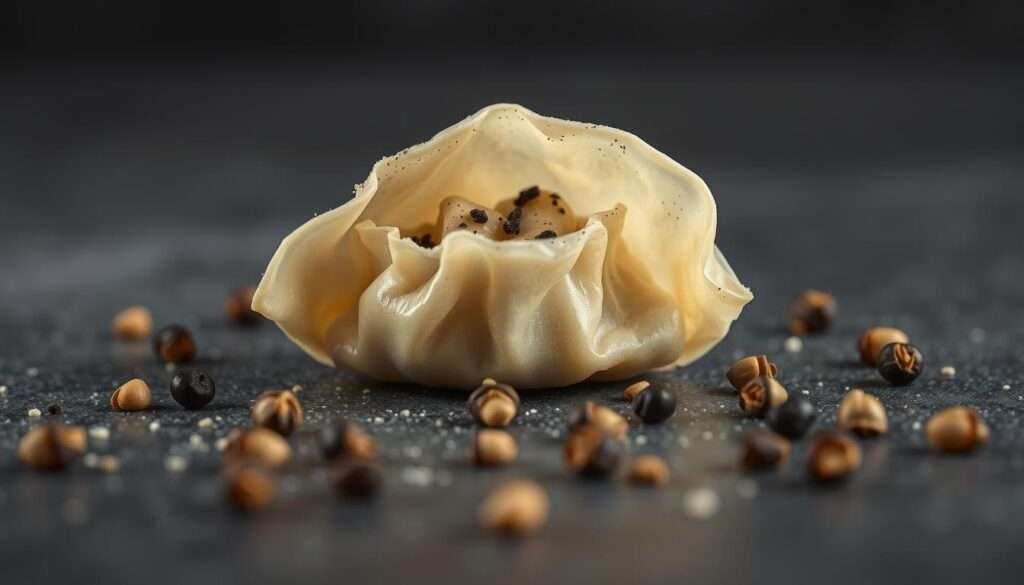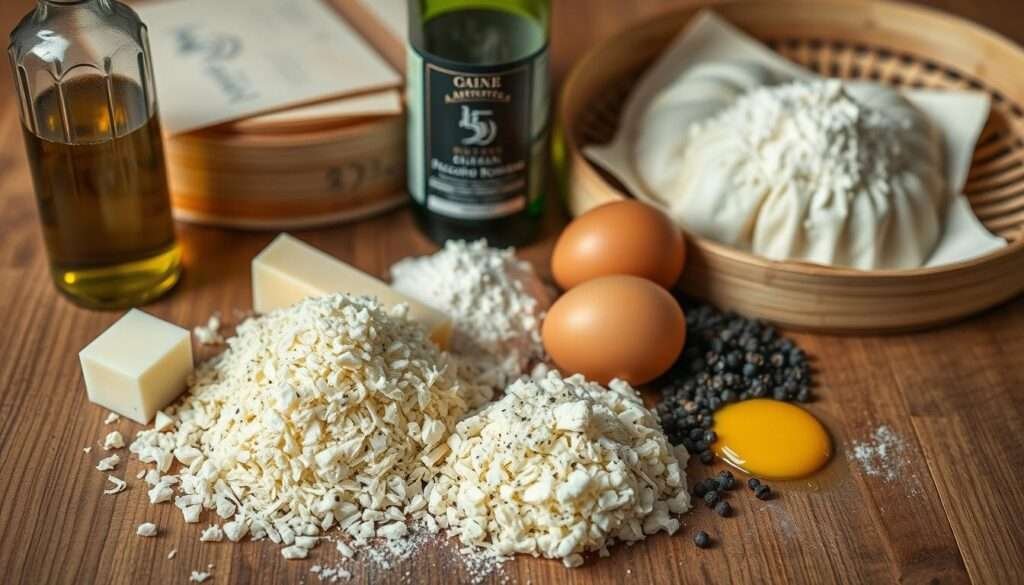Fusion food always excites me, and this recipe is no exception. Inspired by PastaRamen’s creative Montclair menu, it blends Japanese and Italian flavors in the most delicious way. The result? A crispy dumpling with a rich, velvety filling that’s impossible to resist.
What makes this dish special is its simplicity. You don’t need fancy skills to master it. The creamy pecorino and black pepper filling brings Roman pasta vibes, while the golden wrapper adds the perfect crunch. It’s a game-changer for anyone who loves bold flavors.
Whether you serve these as appetizers or a main course, they’re always a hit. The contrast between textures and the umami-packed taste will impress your guests. Trust me—this recipe is easier than it looks and totally worth trying!
The Magic of Cacio e Pepe Gyoza
The blend of Italian and Japanese flavors in this dish is a match made in culinary heaven. It’s a fusion that works surprisingly well, combining the richness of pecorino cheese with the delicate crunch of dumplings. The result is a dish that’s both comforting and exciting.

A Fusion That Works Surprisingly Well
What makes this recipe stand out is the perfect balance of flavors. The sharpness of pecorino cheese pairs beautifully with the warmth of black pepper. When steamed, the cheese melts into a creamy sauce that’s smoother than traditional pasta methods. It’s a texture you’ll love from the first bite.
I was amazed at how the black pepper becomes more nuanced when cooked inside the dumpling. It’s not just spicy—it’s complex and aromatic. This dish avoids the common pitfalls of fusion food by staying true to the essence of both cuisines.
Why This Recipe Beats Traditional Gyoza
Compared to classic pork or vegetable gyoza, this version offers a unique twist. The cheese filling is rich and velvety, creating a contrast with the crispy wrapper. Michelin-starred chefs have been experimenting with Italian-Japanese techniques, and this recipe feels like a nod to their creativity.
When I tested my first batch, I had an “aha moment.” The flavors were so harmonious, and the process was simpler than I expected. Pair it with a crisp white wine or a light beer, and you’ve got a meal that’s both elegant and approachable.
- The cheese-pepper synergy is a game-changer.
- Steaming preserves the sauce’s creamy consistency.
- Black pepper adds depth when cooked in the filling.
- Perfect for wine or beer pairings.
Ingredients You’ll Need for Cacio e Pepe Gyoza
This recipe brings together two iconic flavors in a way that’s both surprising and satisfying. To make it, you’ll need a few key ingredients that are easy to find. Here’s everything you need to get started.

Cheese Selection: Pecorino vs. Parmesan
Choosing the right cheese is crucial. Pecorino Romano is my go-to for its sharp, salty flavor. Parmigiano-Reggiano works too, but it’s milder. For this recipe, I recommend 100g of Pecorino for the filling.
Dough Essentials: Flour and Egg Ratio
The dough is simple but important. Use 200g of tipo 00 flour for a smooth texture. Add 65ml of water and one egg at room temperature. This ensures the dough is elastic and easy to work with.
Black Pepper: The Star Spice
Freshly cracked Tellicherry peppercorns are a must. They add depth and warmth to the filling. Use about 1 tablespoon for the perfect balance of flavor.
Here’s a quick cost comparison and shelf life guide for the ingredients:
| Ingredient | Cost (Homemade) | Cost (Restaurant) | Shelf Life |
|---|---|---|---|
| Pecorino Romano | $8 | $15 | 2 months |
| Tipo 00 Flour | $5 | $10 | 6 months |
| Tellicherry Peppercorns | $6 | $12 | 1 year |
If you’re short on time, premade wrappers are a great alternative. Look for brands like Nasoya or Twin Marquis. For gluten-free options, try using rice flour or almond flour.
This recipe is all about simplicity and flavor. With the right ingredients, you’ll create a dish that’s both impressive and easy to make. Happy cooking!
Step-by-Step Guide to Making Cacio e Pepe Gyoza
Creating this dish is a fun and rewarding experience that anyone can master. With clear instructions and a bit of patience, you’ll have a plate of golden, flavorful dumplings in no time. Let’s dive into the process.
Preparing the Dough and Filling
Start by making the dough. Combine 200g of tipo 00 flour with 65ml of water and one egg. Knead until smooth and elastic. Let it rest for 15 minutes while you prepare the filling.
For the filling, grate 100g of Pecorino Romano cheese and mix it with 1 tablespoon of freshly cracked Tellicherry peppercorns. The cheese should be at room temperature to ensure it melts evenly during cooking.
Folding and Sealing the Gyoza Like a Pro
Roll out the dough into thin circles. Place a teaspoon of filling in the center of each wrapper. Dip your finger in water and moisten the edges to help seal them.
Fold the wrapper in half and crimp the edges with your fingers. Aim for 5-7 pleats on each side for a professional look. Ensure the edges are sealed tightly to prevent leaks during cooking.
Cooking to Perfection: Pan-Fry or Steam?
Heat a non-stick pan over medium heat. Add a drizzle of oil and place the dumplings in the pan. Cook for 2 minutes until the bottoms are golden brown.
Add ¼ cup of water to the pan and cover immediately. Steam for another 2 minutes until the wrappers are slightly transparent. This hybrid method gives you a crispy bottom and a tender top.
For more tips on perfecting your dumpling techniques, check out this detailed guide.
- Total time: 35 minutes (15 prep, 20 cooking).
- Common mistakes: Overfilling or not sealing edges properly.
- Visual indicators: Wrappers turn golden and slightly transparent when done.
- Storage: Best enjoyed fresh, but can be frozen for up to 2 months.
Ready to Fall in Love With This Dish?
This dish is a gateway to exploring bold, creative flavors in your kitchen. It’s perfect for hosting fusion dinner parties or experimenting with your own twists. Try drizzling truffle oil or adding prosciutto for an extra layer of flavor. The Instagram-worthy presentation alone will impress your guests.
Chefs like Michael Mina have shown how innovative combinations can elevate food. This recipe is your chance to channel that same creativity. It’s simpler than it looks, and the results are unforgettable. Don’t be intimidated—first-time dumpling makers can nail this with ease.
For more inspiration, check out this guide to Italian fusion. It’s packed with tips and success stories to fuel your culinary adventures. Share your creations, leave reviews, and let this recipe be your stepping stone to advanced fusion cooking.
